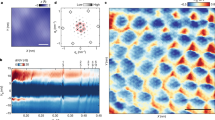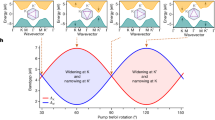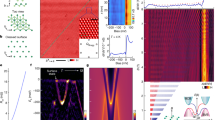Abstract
Quantum entanglement is a fundamental phenomenon that, on the one hand, reveals deep connections between quantum mechanics, gravity and spacetime1,2, and on the other hand, has practical applications as a key resource in quantum information processing3. Although it is routinely achieved in photon–atom ensembles4, entanglement involving solid-state5,6,7 or macroscopic objects8 remains challenging albeit promising for both fundamental physics and technological applications. Here, we report entanglement between collective, chiral vibrations in a two-dimensional WSe2 host—chiral phonons (CPs)—and single-photons emitted from quantum dots9,10,11,12,13 (QDs) present in it. CPs that carry angular momentum were recently observed in WSe2 and are a distinguishing feature of the underlying honeycomb lattice14,15. The entanglement results from a ‘which-way’ scattering process, involving an optical excitation in a QD and doubly-degenerate CPs, which takes place via two indistinguishable paths. Our unveiling of entanglement involving a macroscopic, collective excitation together with strong interactions between CPs and QDs in two-dimensional materials opens up ways for phonon-driven entanglement of QDs and engineering chiral or non-reciprocal interactions at the single-photon level.
This is a preview of subscription content, access via your institution
Access options
Access Nature and 54 other Nature Portfolio journals
Get Nature+, our best-value online-access subscription
$29.99 / 30 days
cancel any time
Subscribe to this journal
Receive 12 print issues and online access
$209.00 per year
only $17.42 per issue
Buy this article
- Purchase on Springer Link
- Instant access to full article PDF
Prices may be subject to local taxes which are calculated during checkout




Similar content being viewed by others
Data availability
The data that support the plots within this paper and other findings of this study are available from the corresponding author upon reasonable request.
References
Maldacena, J. & Susskind, L. Cool horizons for entangled black holes. Fortschr. Phys. 61, 781–811 (2013).
Cao, C., Carroll, S. M. & Michalakis, S. Space from Hilbert space: recovering geometry from bulk entanglement. Phys. Rev. D 95, 024031 (2017).
Nielsen, M. A. & Chuang, I. L. Quantum Computation and Quantum Information: 10th Anniversary Edition (Cambridge Univ. Press, Cambridge, 2010).
Moehring, D. L. et al. Entanglement of single-atom quantum bits at a distance. Nature 449, 68–71 (2007).
Gao, W. B., Fallahi, P., Togan, E., Miguel-Sanchez, J. & Imamoğlu, A. Observation of entanglement between a quantum dot spin and a single photon. Nature 491, 426–430 (2012).
De Greve, K. et al. Quantum-dot spin–photon entanglement via frequency downconversion to telecom wavelength. Nature 491, 421–425 (2012).
Dolde, F. et al. Room-temperature entanglement between single defect spins in diamond. Nat. Phys. 9, 139–143 (2013).
Lee, K. C. et al. Entangling macroscopic diamonds at room temperature. Science 334, 1253–1256 (2011).
Srivastava, A. et al. Optically active quantum dots in monolayer WSe2. Nat. Nanotech. 10, 491–496 (2015).
Koperski, M. et al. Single photon emitters in exfoliated WSe2 structures. Nat. Nanotech. 10, 503–506 (2015).
Chakraborty, C., Kinnischtzke, L., Goodfellow, K. M., Beams, R. & Vamivakas, A. N. Voltage-controlled quantum light from an atomically thin semiconductor. Nat. Nanotech. 10, 507–511 (2015).
He, Y.-M. et al. Single quantum emitters in monolayer semiconductors. Nat. Nanotech. 10, 497–502 (2015).
Tonndorf, P. et al. Single-photon emission from localized excitons in an atomically thin semiconductor. Optica 2, 347–352 (2015).
Zhu, H. et al. Observation of chiral phonons. Science 359, 579–582 (2018).
Zhang, L. & Niu, Q. Chiral phonons at high-symmetry points in monolayer hexagonal lattices. Phys. Rev. Lett. 115, 115502 (2015).
Xu, X., Yao, W., Xiao, D. & Heinz, T. F. Spin and pseudospins in layered transition metal dichalcogenides. Nat. Phys. 10, 343–350 (2014).
Xiao, D., Liu, G.-B., Feng, W., Xu, X. & Yao, W. Coupled spin and valley physics in monolayers of MoS2 and other group-VI dichalcogenides. Phys. Rev. Lett. 108, 196802 (2012).
Mak, K. F., He, K., Shan, J. & Heinz, T. F. Control of valley polarization in monolayer MoS2 by optical helicity. Nat. Nanotech. 7, 494–498 (2012).
Zeng, H., Dai, J., Yao, W., Xiao, D. & Cui, X. Valley polarization in MoS2 monolayers by optical pumping. Nat. Nanotech. 7, 490–493 (2012).
Cao, T. et al. Valley-selective circular dichroism of monolayer molybdenum disulphide. Nat. Commun. 3, 887 (2012).
DiCarlo, L. et al. Preparation and measurement of three-qubit entanglement in a superconducting circuit. Nature 467, 574–578 (2010).
Steffen, M. et al. Measurement of the entanglement of two superconducting qubits via state tomography. Science 313, 1423–1425 (2006).
Luo, X. et al. Effects of lower symmetry and dimensionality on Raman spectra in two-dimensional WSe2. Phys. Rev. B 88, 195313 (2013).
Kim, S., Kim, K., Lee, J.-U. & Cheong, H. Excitonic resonance effects and Davydov splitting in circularly polarized Raman spectra of few-layer WSe2. 2D Mater. 4, 045002 (2017).
Branny, A., Kumar, S., Proux, R. & Gerardot, B. D. Deterministic strain-induced arrays of quantum emitters in a two-dimensional semiconductor. Nat. Commun. 8, 15053 (2017).
Palacios-Berraquero, C. et al. Atomically thin quantum light-emitting diodes. Nat. Commun. 7, 12978 (2016).
Palacios-Berraquero, C. et al. Large-scale quantum-emitter arrays in atomically thin semiconductors. Nat. Commun. 8, 15093 (2017).
Gammon, D., Snow, E. S., Shanabrook, B. V., Katzer, D. S. & Park, D. Fine structure splitting in the optical spectra of single GaAs quantum dots. Phys. Rev. Lett. 76, 3005–3008 (1996).
Sidler, M. et al. Fermi polaron–polaritons in charge-tunable atomically thin semiconductors. Nat. Phys. 13, 255–261 (2016).
He, Y.-M. et al. Cascaded emission of single photons from the biexciton in monolayered WSe2. Nat. Commun. 7, 13409 (2016).
Heitz, R., Mukhametzhanov, I., Stier, O., Madhukar, A. & Bimberg, D. Enhanced polar exciton-LO-phonon interaction in quantum dots. Phys. Rev. Lett. 83, 4654–4657 (1999).
Cai, Y., Lan, J., Zhang, G. & Zhang, Y.-W. Lattice vibrational modes and phonon thermal conductivity of monolayer MoS2. Phys. Rev. B 89, 035438 (2014).
Srivastava, A. et al. Valley Zeeman effect in elementary optical excitations of monolayer WSe2. Nat. Phys. 11, 141–147 (2015).
Aivazian, G. et al. Magnetic control of valley pseudospin in monolayer WSe2. Nat. Phys. 11, 148–152 (2015).
Chen, S.-Y., Zheng, C., Fuhrer, M. S. & Yan, J. Helicity-resolved Raman scattering of MoS2, MoSe2, WS2, and WSe2 atomic layers. Nano. Lett. 15, 2526–2532 (2015).
Drapcho, S. G. et al. Apparent breakdown of Raman selection rule at valley exciton resonances in monolayer MoS2. Phys. Rev. B 95, 165417 (2017).
Yoshikawa, N., Tani, S. & Tanaka, K. Raman-like resonant secondary emission causes valley coherence in CVD-grown monolayer MoS2. Phys. Rev. B 95, 115419 (2017).
Geim, A. K. & Grigorieva, I. V. Van der Waals heterostructures. Nature 499, 419–425 (2013).
Castellanos-Gomez, A. et al. Deterministic transfer of two-dimensional materials by all-dry viscoelastic stamping. 2D Mater. 1, 011002 (2014).
Acknowledgements
We acknowledge many enlightening discussions with A. Imamoğlu, W. Gao and M. Kroner. We also acknowledge technical help from T. Neal and E. Liu. A.S. acknowledges support from Emory University startup funds and the National Science Foundation through the EFRI Program grant number EFMA-1741691. L.Z. thanks M. Gao for helpful calculations and discussions, and acknowledges support from the National Natural Science Foundation of China (grant No. 11574154). Q.X. gratefully acknowledges strong support from the Singapore National Research Foundation via an NRF-ANR joint grant (NRF2017-NRF-ANR002 2D-Chiral) and the Singapore Ministry of Education via an AcRF Tier2 grant (MOE2017-T2-1-040) and Tier1 grants (RG 113/16 and RG 194/17)
Author information
Authors and Affiliations
Contributions
X.C., X.L., S.D. and Q.Y. carried out the quantum dot measurements and S.L. measured the Raman data. X.L. and X.W. prepared the samples. A.S., L.Z. and Q.X. supervised the project. All authors were involved in analysis of the experimental data and contributed extensively to this work.
Corresponding author
Ethics declarations
Competing interests
The authors declare no competing interests.
Additional information
Publisher’s note: Springer Nature remains neutral with regard to jurisdictional claims in published maps and institutional affiliations.
Supplementary information
Supplementary information
Supplementary Text, Figure 1–13 and Supplementary References
Rights and permissions
About this article
Cite this article
Chen, X., Lu, X., Dubey, S. et al. Entanglement of single-photons and chiral phonons in atomically thin WSe2. Nat. Phys. 15, 221–227 (2019). https://doi.org/10.1038/s41567-018-0366-7
Received:
Accepted:
Published:
Issue Date:
DOI: https://doi.org/10.1038/s41567-018-0366-7
This article is cited by
-
Room-temperature phonon-coupled single-photon emission in hexagonal boron nitride
Science China Physics, Mechanics & Astronomy (2024)
-
The Roadmap of 2D Materials and Devices Toward Chips
Nano-Micro Letters (2024)
-
Chiral-phonon-activated spin Seebeck effect
Nature Materials (2023)
-
Revealing broken valley symmetry of quantum emitters in WSe2 with chiral nanocavities
Nature Communications (2023)
-
Chiral phonons in quartz probed by X-rays
Nature (2023)



